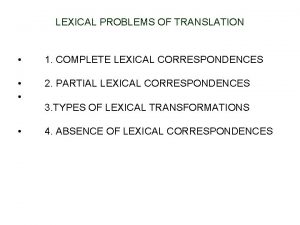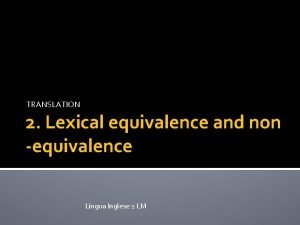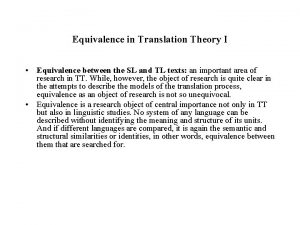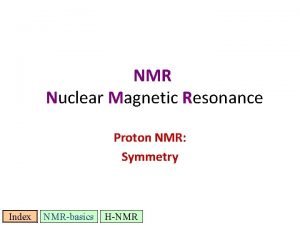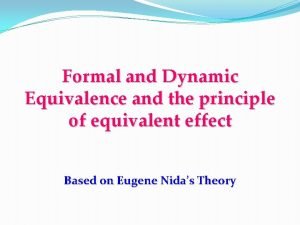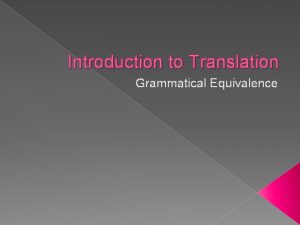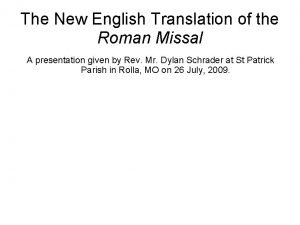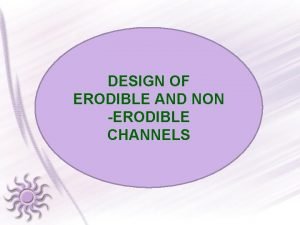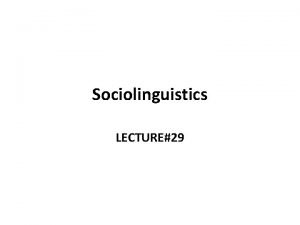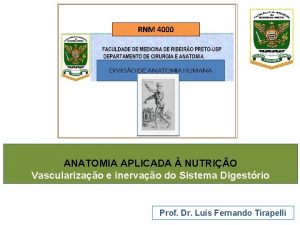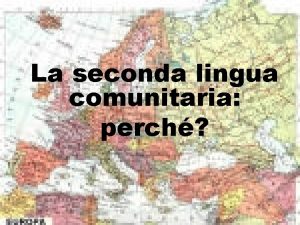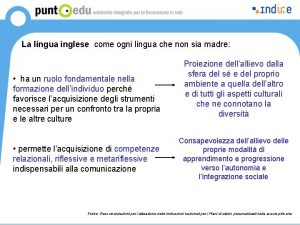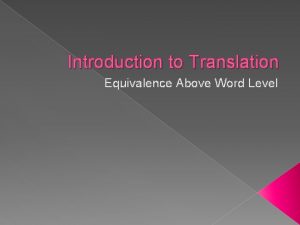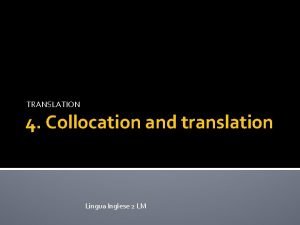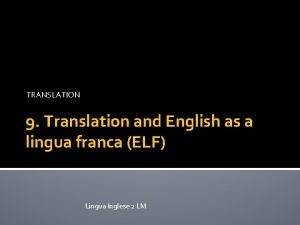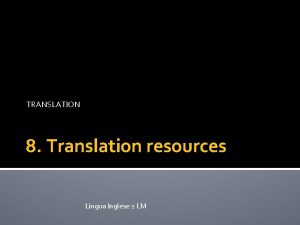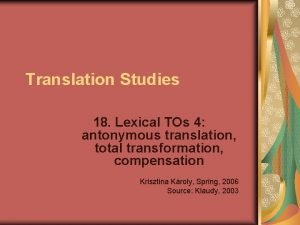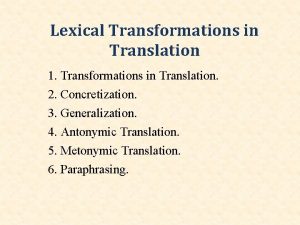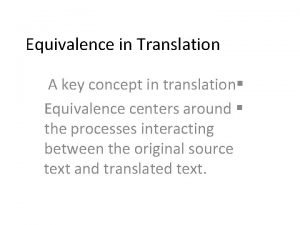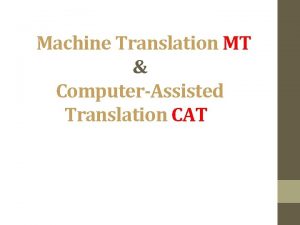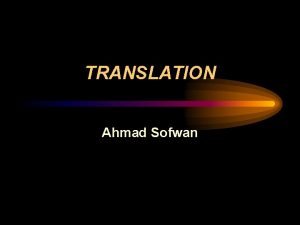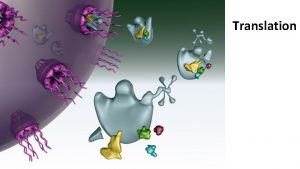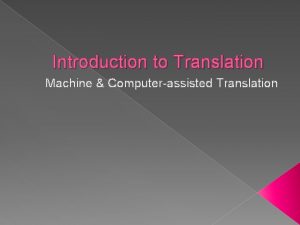TRANSLATION 2 Lexical equivalence and non equivalence Lingua




























- Slides: 28

TRANSLATION 2. Lexical equivalence and non -equivalence Lingua Inglese 2 LM

Do these pairs mean the same thing? enough sufficient insane mad whinge complain autumn fall regal kingly deep profound fraternal brotherly sodium chloride freedom liberty endless everlasting purchase buy verily really salt 2

Lexical relations - SYNONYMY � Synonyms are lexemes which have the same meaning � English has a lot of synonyms because its vocabulary comes from different sources (Anglo-Saxon, Latin, Greek, French) � But is it possible to have true synonyms, i. e. words with exactly the same meaning? 3

Distinguishing meanings � some words only occur in particular geographical contexts (e. g. autumn-fall) or temporal contexts (e. g. verily-really) � some words only occur in certain registers (salt and sodium chloride) � some words only occur in certain collocations (deep water but not profound water) � some words are emotionally stronger (e. g. whinge, not complain) � Some words overlap in meaning but are not identical (e. g. murmur and mutter) 4

Translating into English - awareness Awareness of: �distinctions between varieties of english when translating a word like “autunno” �temporal distinctions – e. g. Bible translation of “veramente” �whether English registers correspond to Italian ones? �whether English collocations correspond to Italian ones �overlapping lexical meanings in English

Tramslators’ awareness of overlapping meanings � They need to understand the subtle differences in synonyms and lexical fields in the SL – e. g. the difference in usage between mormorare and mugugnare in Italian � They need to understand the subtle differences in the synonyms and lexical fields in the TL, e. g. the difference in usage between mumble, murmur and mutter in English � They need to see if they can match the two � They need to know what to do when they don’t match (non-equivalence)

Tvorog – but what about the TL? 7

1. The concept does not exist in the TL e. g. privacy airing cupboard Speaker of the House of Commons Most of the concepts expressed by these words are unknown in other cultures. What does the translator do with them?

2. The concept is not lexicalised in TL e. g. standard (standard range of products) landslide victory �These words are easily understood but they do not have an easy equivalent in the TL. Specific types of non-lexicalisation are ….

2 a Types of non-lexicalisation e. g. how do you translate facilities The university has a lot of facilities for students Lack of a superordinate term �TL may have words for types of facilities (bank, housing, canteen) but not the umbrella term.

Non equivalent words Problems for the translator: �the concept does not exist in the TL �the concept is not lexicalised in the TL �the SL word is semantically complex �SL and TL make different distinctions in meaning �differences in physical or interpersonal perspective �differences in form �use of loan words in ST

3. SL word is semantically complex e. g.

4. SL and TL make different distinctions in meaning e. g. kehujanan = go out in the rain without knowing that it is raining hujanan = go out in the rain knowing that it is raining How do you translate “he went out in the rain” into Indonesian?

5. Differences in physical or interpersonal perspective e. g. “Libertà” freedom or liberty ? Which word did Mel Gibson use in Braveheart?

6. Differences in form e. g. employer/employee boyish, hellish legalese �TL may not have the same distinctions in meaning in the use of affixes

7. Use of loan words in the ST e. g. au fait, chic, dilettante �Loan words used in SL are often used to convey a sense of prestige. How do you achieve this in the TL?

2. b. Types of non-lexicalisation Lack of a specific term (hyponym) e. g. under the superordinate house we find: bungalow, cottage, croft, chalet, lodge, hut, mansion, manor, villa, hall �TL may not have specific hyponyms for each hyponym in the SL because they are not relevant to their environment

Translation Strategies �What strategies do translators use for dealing with the problem of non-equivalence in words.

1. Translation by a more general word (superordinate) �Shampoo the hair with a mild WELLA SHAMPOO Lavare i capelli …. . Lavare is less specific than shampoo but the only possible translation. The satellite is still orbiting the Earth

1. Translation by a less specific word (superordinate) �Shampoo the hair with a mild WELLA SHAMPOO Lavare i capelli …. . Lavare is less specific than shampoo but the only possible translation. The satellite is still orbiting the Earth

What are the strategies here? �The Patrick Collection has a restaurant to suit every taste – from the discerning gourmet to the Cream Tea expert How do you deal with Cream Tea ?

2. Translation by cultural substitution �The Patrick Collection has a restaurant to suit every taste – from the discerning gourmet to the Cream Tea expert � ………. di soddisfare tutti i gusti: da quelli del gastronomo esigente a quelli dell’esperto di pasticceria

3. Translation by paraphrase �The Patrick Collection has a restaurant to suit every taste – from the discerning gourmet to the Cream Tea expert �… de la table gourmande au Salon de Thé à l’anglaise is a paraphrase strategy (avoids explanation of what a Cream Tea is but suggests its uniqueness)

4 a. Translation by original term plus explanation The translator has to decide how much information and what kind of information the reader needs to know. The type of gloss used depends on how much info is needed and the text type: �Intratextual gloss (added into the text) - St Paul’s > St Paul’s Cathedral - Jeremy Corbyn > Jeremy Corbyn il capo laburista - Waitrose > Il supermercato Waitrose

4 b. Translation by original term plus explanation �Extratextual gloss (footnote, endnote, glossary) Main text of translation - before recovering the beans, arrucao’ is required: Footnote of translation ‘ arrucao: clearing the ground under coffee trees of rubbish and piling it in the middle of the row in order to aid in the recovery of beans dropped during harvesting

5. Translation by omission �“il concerto ci ha regalato tante emozioni” The concert was very emotional for us �Here the idea of “giving something away for free” in regalare is lost

6. Translation by illustration

Summary of strategies for dealing with non-equivalence at word level �Translation by a more general word (superordinate) �Translation by cultural substitution �Translation by paraphrase �Translation by original expression plus explanation or added information �Translation by omission �Translation by illustration
 Lexical problems in translation
Lexical problems in translation Lexical equivalent
Lexical equivalent Otto kade types of equivalence
Otto kade types of equivalence Invia est in medicina via sine
Invia est in medicina via sine Chemical equivalence and magnetic equivalence
Chemical equivalence and magnetic equivalence Eugene nida formal and dynamic equivalence
Eugene nida formal and dynamic equivalence Formal equivalence vs. dynamic equivalence ni eugene nida
Formal equivalence vs. dynamic equivalence ni eugene nida Communicative meaning in semantics
Communicative meaning in semantics Square root function transformations
Square root function transformations Se yon bel pale kristal chant d'esperance
Se yon bel pale kristal chant d'esperance Word level translation problems
Word level translation problems Grammatical equivalence
Grammatical equivalence Voice translation-rule
Voice translation-rule Semantic translation và communicative translation
Semantic translation và communicative translation New english translation of the roman missal pdf
New english translation of the roman missal pdf In kennedy theory the value of constant c for coarse silt
In kennedy theory the value of constant c for coarse silt Tpicos
Tpicos Define “lingua franca.”
Define “lingua franca.” Nervo hipoglosso
Nervo hipoglosso Luanda lingua oficial
Luanda lingua oficial Lingua sannita
Lingua sannita Parametros curriculares nacionais lingua portuguesa
Parametros curriculares nacionais lingua portuguesa Le origini della letteratura italiana mappa concettuale
Le origini della letteratura italiana mappa concettuale Nulla est medicina sine lingua latina
Nulla est medicina sine lingua latina Invia est in medicina via sine lingua latina
Invia est in medicina via sine lingua latina Lingua epitelio cheratinizzato
Lingua epitelio cheratinizzato Preposições
Preposições Mappa lingue indoeuropee
Mappa lingue indoeuropee Seconda lingua comunitaria
Seconda lingua comunitaria
